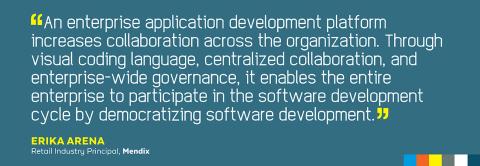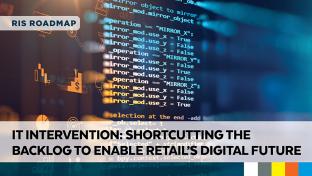How to Innovate and Modernize Simultaneously With Your Existing IT Teams

Today’s retail IT teams are tasked with creating both operational efficiencies and superior experiences for consumers. From the warehouse to associates on the store floor, retailers are undergoing digital transformations that both innovate and update operations, but these transformations stretch IT resources.
Simplifying the ways IT teams develop digital solutions can address the challenges caused by legacy solutions and IT project backlogs, as well as increase collaboration across the organization. RIS sits down with Erika Arena, retail industry principal, Mendix, to discuss how retailers can increase the capacity of their IT teams to tackle digital transformation and stay on top of innovation.
RIS: What are the top factors holding retail IT departments back in keeping up with digital transformation demands?
Erika Arena: IT teams are flooded with requests from their companies. According to the Gartner CIO Agenda 2021, 76% of CIOs report an increased demand for new digital products and services. As retailers continue to prioritize modernization, they find themselves squeezed for the IT resources needed to create operational efficiencies and better experiences. To increase the capacity of their IT teams to tackle digital transformation, retailers should consider:
- Increasing collaboration between those setting digital transformation strategy and those executing it.
- Decreasing lengthy application planning and delivery cycles so teams can more quickly produce results.
- Shifting IT investments from maintaining complex legacy systems to building more innovative solutions. Half of IT departments spend at least 70% of their budget on maintaining legacy systems, according to the 2022 Win with Customer Experiences survey. By investing in composable capabilities, retailers can extend their legacy systems while keeping their core systems clean.

RIS: Why is simplifying the ways teams develop digital solutions an effective strategy for addressing the challenges caused by legacy solutions and IT project backlogs?
Arena: Building digital solutions with an enterprise application development platform enables retailers to achieve three things:
- It allows them to innovate and modernize at the same time. Teams can create new experiences by tying together existing systems and data sources, and then modernize these backend systems without impacting user experience.
- It helps them to achieve faster delivery of digital solutions by reducing skillset silos on the IT teams, by building reusable, composable components, and by bringing in more of the enterprise to assist in building digital solutions.
- Lastly, these platforms simplify the introduction of new technology for creating innovative experiences and gathering data from across the organization, network, and customers.

RIS: How does using an enterprise app development platform improve the digital transformation process?
Arena: An enterprise application development platform increases collaboration across the organization. Through visual coding language, centralized collaboration, and enterprise-wide governance, it enables the entire enterprise to participate in the software development cycle by democratizing software development. It also accelerates the delivery of digital solutions by providing a cloud-native and cloud-agnostic platform that offers one-click deployments and the ability to build native-mobile applications without specific skillsets.
And, of course, the right platform partner will provide the expertise to guide organizations on their digital transformation journey, selecting the right projects and building an application portfolio of quick wins that provide high value.
RIS: What are some of the most impactful uses of enterprise application development platforms you have seen in retail?
Arena: The 2022 State of Low-Code in Key Verticals survey identified increased cross-organization collaboration (store, catalog, shared data, and visibility), better customer service and problem-solving, and synchronization of customer data sources as some of the highest value benefits for retailers who have adopted an enterprise application development platform.
We’ve seen tremendous value from retailers building experience layers that create a single source of truth for multiple teams inside and outside the organization. Great examples include product design and development, vendor onboarding and management, and other operational activities like inventory transfers and employee scheduling. We’ve also seen impactful benefits for retailers who use the platform to increase their mobile capabilities. They’re building apps to create smoother shopping experiences, improve warehouse operations, and give in-store employees unprecedented access to data on-the-go. With a modern application development platform, the use cases are endless!



